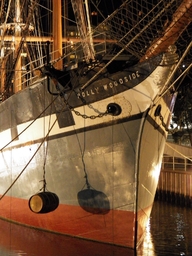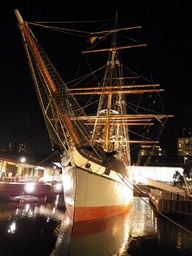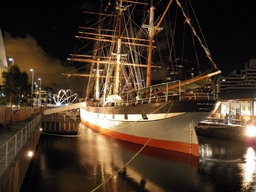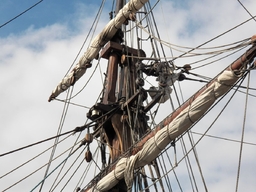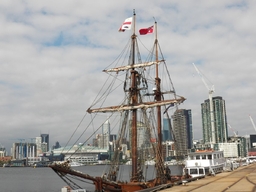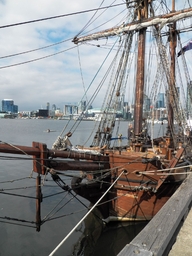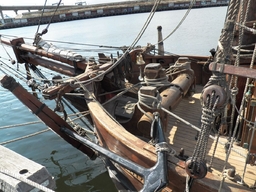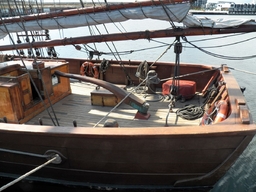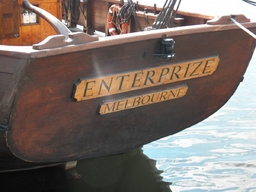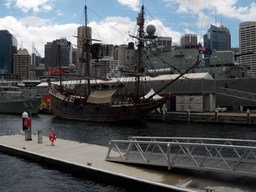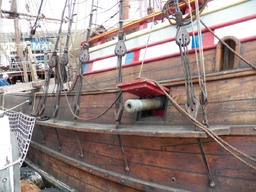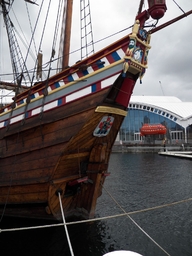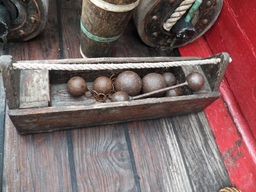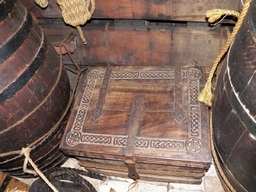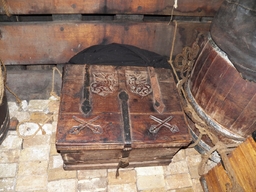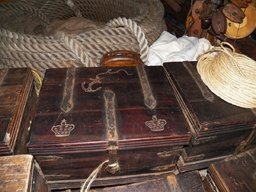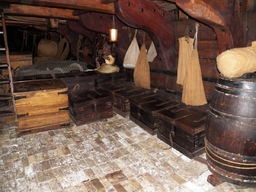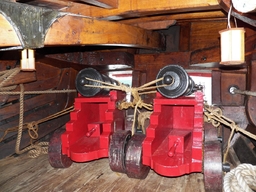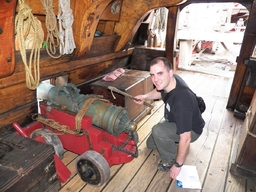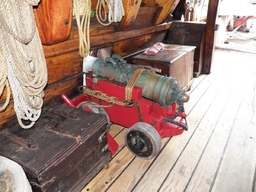-
Posts
1,026 -
Joined
-
Last visited
Content Type
Profiles
Forums
Events
Gallery
Everything posted by Coastie04
-
Definitely looking better than the floating hulk she was just a few years ago! Great job and good luck in the future as well! Arrrgh!
-
I love the stiletto one! Just in case you're surprised while reloading or servicing your pistol... Arrrgh!
-
drool...
-
Happy birthday and best of luck circumnavigating Sol next time as well. Arrrgh!
-

And Still Yet Another Decemberists... Happy Birthday Foxe!
Coastie04 replied to Jas. Hook's topic in Scuttlebutt
Congrats on another circumnavigation of Sol! Arrrgh! -
I came across this website which seems to at least have a large collection of historic Spanish flags. However, the vast majority are not actual surviving examples, but computer renditions. However, it might be a good place to start, and you might be able to contact the owner of the site for more information. http://www.crwflags.com/fotw/flags/es_his.html Arrrgh!
-
I found a nice article about the sinking of the Bounty that doesn't universally condemn the captain for getting underway before the storm. So many of the articles and posts out there have ignorantly blamed the captain, thanks to 20/20 vision and a lack of understanding about ships. I'm not blindly agreeing with his decision, but it was a judgement call that has plenty of sound precedence. It was a bit of a gamble (as is sailing an anachronism in the first place), and ultimately he lost. The first link is to an article that might shed some light on the captain's thought process. http://www.heraldnews.com/opinions/x1922372993/GUEST-OPINION-Bountys-crew-faced-a-dilemma-Sail-or-seek-safe-harbor This second article definitely blames the captain for taking the risk (though is incorrect in its description of hurricane sailing tactics) and suggests that the captain wanted to save the ship so that it could be sold for $4.6 million. Of course, the ship has been for sale for years and hasn't sold yet. Of course, even if economics came in to play during the decision to sail, that's nothing new. If it was a fishing boat, there'd probably be a TV show about it. Back to this article, it is the most in depth description of what happened onboard that I have yet to see. Of special note is the engineering failures, which had been eluded to, but not in such detail. Granted, the fact that the ship was taking in so much water in the first place is not a good thing, but the pumps failing was ultimately the demise. http://abcnews.go.com/International/legendary-ships-final-hours-battling-sandy/story?id=17849018#.UL6vhYM0XTo
- 49 replies
-
- hms bounty
- hms bounty shipwrecked
- (and 4 more)
-
Another good reference is the book "Six Frigates" by Ian W. Toll. Although I don't have a copy on hand to pull a quote or two from, I do recall that since these six sister ships (as much as wooden boats can be, especially back then and built in different cities) were actually built in different yards by different shipwrights, that they had extremely different sailing qualities. There was also a lot of commentary about the naval yards, their available supplies, and their willingness to part with the best of their stock. Again, it's OOP, but a good read for any nautical history lover. Arrrgh!
-
http://www.tarsmell.com/products.html They've got some pine tar soap and hand cream (bottom of the page). I've used the soap before and it's a pleasant pine tar smell and does work in salt water too (just in case you want to get really authentic for a reenactment, or the shower facilities are just too crowded). You can also get some Stockholm tar to spread liberally on your 'work' garb for that extra authentic look. Arrrgh!
-
Be patient. A good mead takes a while. If you're worried about not seeing instant results, it'll be hard to wait 6 months to a year for the mead to age well. After primary fermentation, I'd recommend letting it sit in secondary (preferably a glass carboy) for a month or more. Then bottle and wait as long as you can (6 months to a year at least). It's extremely difficult if it's good out of the gate (you've at least got to try a little every couple months or so), but it generally gets better and better. Arrrgh!
-
There's a thought...try to obtain some raw lumber for the spars and either hand lathe it (if you want the real authentic look in about 10 years!), or see if someone close by can turn them in to spars for you (Mystic Seaport comes to mind, but there might be someone closer/cheaper). I've got a Sitka Spruce in my front yard that you're free to cut down and have, but I think the shipping from Alaska would make it just a bit prohibitive... Arrrgh!
-
Pyrat XO Reserve is generally my favorite, but on the rocks. I've out grown C.M. Private Stock (though it's still a good mixer), and have recently been very impressed by Kraken (though I usually stay away from spiced rums). However, if I want a good all-round dark rum, Gosling's is extremely good, especially for the price point-easy to drink neat, but cheap enough for a good mixer as well. And I still have fond memories of Black Strap, though more for the company I was in than the rum. Been quite a while since I've had Pusser's, but I did always enjoy that when available. Arrrgh!
-
But where is the rum one? Arrrgh!
-
I heartily agree! This pub seemed much more social before it was so big. You'd think a large group of us would be able to get together on a somewhat non-secular gift exchange based more around breaking the law of the sea than any established religion. Then again, how many pirates really like to give stuff away willingly (except to exotic girls in accommodating ports)? I guess it's just us few, superior gentlemen (and women) who will hopefully escape the noose due to this trifling show of goodwill towards each other. Arrrgh!
-
Here's a question for you. Would the surgical instruments belong to the ship or the surgeon? If they were personal tools, then they'd probably be stored wherever he stored his other personal effects. Many specialists (at least in today's sailing world) have their own special tools that they take with them. Of course, resupplies of medicine and other consumables might come out of the general fund, but didn't navigators usually have their own charts, backstaffs, etc.? I know lots of carpenters have their own tool chest as well. Of course, this might also depend on how good of a surgeon they actually had. Arrrgh!
-
Just to put in a bit of storm tactics at sea, there are generally two accepted strategies for weathering a hurricane. Which one you choose depends on your location in relation to the storm, but other factors such as nearby shoal water or the individual sailing characteristics of your boat must be taken in to account as well. A hurricane is divided into two semicircles, the 'safe' and the 'dangerous.' In the northern hemisphere, the 'safe' place to be is south of the storm (or south-west depending on the direction the hurricane is moving). Here the winds will be less. For example, if a hurricane has 55 kt winds, and is moving at 15 kts, the winds in the safe semicircle will be 44 kts (ironically, about what the Bounty recently foundered in). In the dangerous semicircle, they will be 70 kts-MUCH more dangerous. If you're in the dangerous semicircle , you want the wind on your starboard bow. This will move you away from the center of the storm and behind it as quickly as possible. Of course, if you're sailing at 7 kts, the apparent wind speed will now be around 75 kts (approximate, depending on angle of sailing into the wind). In the safe semicircle, the theory is the same, but you want the wind on your starboard quarter. This will take you away from the eye of the storm and get you behind it as soon as possible. Plus, it will be a much more comfortable ride than beating into the wind and is generally much easier to do in a square rigger. And, that extra speed you get decreases the apparent wind even further and 'surf' down the swells. Still dangerous, but much less so. Of course, it's hard without modern weather information to exactly track a storm's location and direction, but not impossible. Generally, the closer you are to the eye, the faster the wind. Since the wind circles around the eye, the eye is approximately perpendicular to the wind direction. If the wind is backing (going counter clockwise), then you're probably in the safe semicircle. If it's veering, batton down the hatches and put up the smallest sails possible. And tie yourself to something solid. And pray. These are at least the modern practices for hurricanes, and I'd imagine by the 1700s that there was some understanding of what works best at sea. However, I'd love to see if there are any period references to this type of procedure. Arrrgh!
-
After mentioning this topic to my wife, she fully agreed. In college, she was taught to write in the long, verbose kind of way. When she wrote her master's thesis in botany, they edited her 60 page thesis down to 20 pages for publication. That makes it much easier to read AND understand, thus much more valuable. Hopefully that kind of trend can catch on so that current research can be accessible to all. Arrrgh!
-
It would be much easier to read without all those lines through it... However, I do agree. While there is a time and place to be verbose, I've generally used it in school when the teacher requires a 10 page paper on a subject that I just didn't care about, etc. Some of the best papers I ever wrote had the requirement of "make them as long or as short as you need in order to argue your thesis." The teacher didn't care if it was a 2 page paper or a 10 pager. He was harsher on a 10 pager that could have been a 2 pager, though. Personally, I'd agree with Mission that more academic research should be written in common language to make it more accessible for us mere mortals with an interest, but not a career in wading through the fluff. I can understand getting very technical in a paper that warrants it, but at least the abstract with the major findings should be easily readable. Unfortunately, I find that often the abstracts have the opposite problem. They're trying to be so condensed that it's difficult to follow. Maybe more academics should write a summary: longer than an abstract, but generalizing the major points of the article in an easy to read format. It would also probably make for a good publication article. OK, someone else can have the soap box now... Arrrgh!
-
I might suggest also contacting the operators of the Gotheborg III. They've excavated an east indiaman (OK, a little late in period, but still probably a good example for what you're looking for) and they might be able to tell you where they found medical supplies. From their website, http://www.gotheborg.com/project/: With a crew of somewhere between 101-141 (depending on the source-more likely in the 141 range), there is probably a clear need for a sick bay. With so many people, especially at the onset of a voyage, there's bound to be some sickness with so many people from possibly different towns in close proximity. Obviously, with regards to the roll, there were deaths that occurred. With over a hundred people on a long voyage, they probably would have had to make some area to quarantine the sick and injured. Arrrgh!
-
From a practical perspective, I'd say in a smaller vessel that they might have multiple places to work. In battle or during a storm, below deck would seem very likely. Amidships would have the least vessel movement for surgeries. A lot might depend on where they could put a few chests together as a makeshift operating table based on the cargo load. However, as I'm sure you're aware, much of the surgeon's skill would be applied when not in battle with either enemies or elements. Even in calm weather, people would get injuries, diseases (especially after port calls), have fights with each other, slips trips & falls, etc. On a small ship, it seems that the best surgery might be on deck or in the captain's cabin (with at least more light), if he was agreeable to such an intrusion. The last Coast Guard cutter I was assigned to (a 225' buoy tender) had a sick bay, but that was used for a case of severe injury that might require surgery. The wardroom (officer's mess) across the passageway would be used. It had a large table and above the ceiling tiles, additional lighting for an operation. This was a military(ish) vessel commissioned in 2001. Just food for thought. Arrrgh!
-
Those bricks are the ballast. Since she's not sailing with cargo, nor enough stores for a prolonged voyage of discovery, bricks it is. Arrrgh!
-
Sign me up!
-
-
From the album: Coastie04's Photos
© Michael Lamonica
-
- Polly Woodside
- Bow
-
(and 1 more)
Tagged with:
-
From the album: Coastie04's Photos
© Michael Lamonica
-
- Polly Woodside
- Packet
-
(and 1 more)
Tagged with:


